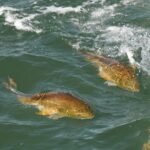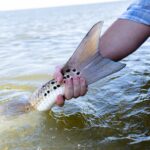
Gulf Menhaden Reduction Fishery: Bycatch Research & Useless Buffer Zones
Do you remember your driver’s test? How nervous were you when the instructor pulled out
By Tony Friedrich, VP/Policy Director
We wanted to give you a quick update on the meeting of the Atlantic Striped Bass Management board yesterday. As usual, Capt. John McMurray will provide a full download next week, but we wanted to touch on the key points are we know this meeting was front-of-mind for many.
For those who want to read up, here are the meeting materials:
Atlantic Striped Bass Management Board Supplemental Supplemental2
And here are the main items that were covered.
Review Report on Striped Bass Release Mortality Sensitivity Runs
The meeting began with a great presentation by Dr. Katie Drew. Dr. Drew presented the findings on Release Mortality Sensitivity Runs. The Technical Committee (TC) ran several models to see how assumptions about post-release mortality (the percentage of recreationally caught striped bass that die after release, also known as discard mortality) impacted the stock status. Five different scenarios were considered: The currently assumed 9% release mortality rate; a low 3% scenario; a high 26% scenario; and two scenarios that assumed differences in post-release mortality based on region and season, respectively. The chart below shows the estimated stock status for the five different levels. As you can see, the fishery is still overfished even if we assume that post-release mortality is only 3%.

We all must do better when it comes to ensuring that released fish survive. However, the chart above shows us that we can only do so much. The reality is that the same states that will call for lowering the reference points are the ones that have put us in this situation. Throughout this entire discussion, no one made mention of the ongoing study being performed by the Massachusetts Division of Marine Fisheries on post-release mortality, which will ultimately provide us with the best available science on the issue. The fact that the Board is continuing to include post-release mortality as an issue in Amendment 7 is a pretty big red flag. Why would this group forge ahead on the issue instead of coordinating with Massachusetts DMF on their ongoing research?
There is a lot more to the post-release mortality situation than just this finding but it does shed light on the fact that the real problem with striped bass is getting very little attention. That is, that the Striped Bass Management Board has either been too slow to react or has completely ignored the Amendment 6 management triggers (Pg 49). In 2014, the Board took steps to address fishing mortality but ignored the 10-year rebuilding timeline., Striped bass were declared overfished in 2019, and are still not on track to rebuild within the require 10-year timeline. New Jersey and Maryland failed to meet their required harvest reductions established in 2014 by exploiting conservation equivalency, but faced no consequences. There is zero accountability.
Consider Stock Assessment Update Timeline
The next agenda item was an update on the stock assessment, which was originally scheduled for 2021. Due to issues with COVID, it is being postponed to 2022. This means that we won’t know if the new regulations from Addendum 6—chief among them, the slot limit—were effective. During this discussion, ASGA President Capt. John McMurray asked if it made sense to hit the pause button on Amendment 7 due to this lack of data. His suggestion was met with crickets.
Consider Draft Amendment 7 Public Information Document for Public Comment
The discussion then shifted to approving the Public Information (PID) Document. This document, whose development began last summer, will be circulated to public to gather input on Amendment 7’s nine issues. We found out that some the PID language on Issue 2, Biological Reference Points, had recently been adjusted. The second sentence on the below slide conflates opinion with scientific results, but is going to be sent out to the public as-is.

Let me explain. If the 2018 benchmark stock assessment found that overfishing was occurring during a historically high stock level. It is a bit of a stretch to suggest we can’t reach target when we are overfishing. How this translates to the current reference points being unattainable is beyond our comprehension. The commissioner who requested the change is pushing hard for a higher commercial quota for his state, Delaware. So, this shows us the levels that commissioners will go to further their own state interests. Recovering the stock, which is currently at a 25-year low, was never discussed.
The PID was approved. We don’t know if the new regulations are working. The stock assessment has been postponed for a year. Massachusetts is doing groundbreaking work on catch and release mortality, but it won’t be done in time to use in the amendment. All of these state hearings will most likely be virtual. That has never been done. Will the comments be recorded correctly? Will the technology work? Will people be able to speak? Who knows? But, what the heck, let’s get this document out there, we have striped bass to kill.
All of these agenda items took about an hour. I checked the metadata on the photo. The meeting started at 1:45 PM. The slide above was downloaded to my PC at 3:01 PM. For the next 3+ hours, we all got to listen to the board discuss a tube and worm rig.
To be fair, we helped craft the letter that asked for the tube and worm exemption. It is an issue of lack of foresight in crafting Addendum VI, and is more a matter of correcting a previous mistake than adding a new exemption. This is a clear issue of the letter versus the spirit of the new regulation. The use of circle hooks is intended to lower release mortality when using bait. If someone can explain to us how using a circle hook on a 3-foot trolling lure will lower mortality, we are all ears. But alas, the board decided to take up over 3 hours of all of our lives discussing the issue.
There were just under 300 people on the call. They tuned in because they care about striped bass. They want to understand what is going on. They want their commissioners to actually do something to restore the stock. Instead, we got to listen to 200 minutes of inefficiency that was on full display to the public. 200 minutes of fiddling while Rome burns. 200 minutes of people talking to hear themselves talk. 200 minutes for something that should have taken 5.
At one point, Justin Davis from CT reminded the board that the public is losing faith. His words went unheeded. We would like to point out that there are some great commissioners and that the staff at ASMFC is very good. However, the process is shattered. Certain commissioners spend most of their time horse trading for votes that are important to their respective states rather than managing the resource.
We talk about accountability for states using conservation equivalency. How about accountability for ASMFC? Amendment 6 clearly states the following on striped bass.
2.6.1 Stock Rebuilding Targets
Should the Atlantic striped bass population be overfished at anytime in the future, it is the intent under Amendment 6 to rebuild the female spawning stock biomass to the target level (38.6 million pounds) within the timeframe established in Section 2.6.2.
2.6.2 Stock Rebuilding Schedules
If at anytime the Atlantic striped bass population is declared overfished and rebuilding needs to occur, the Management Board will determine the rebuilding schedule at that time. The only limitation imposed under Amendment 6 is that the rebuilding schedule is not to exceed 10 years.
At the August 2019 meeting, former ASMFC Striped Bass Management Plan Coordinator Max Appleman advised the board that the clock was ticking. In other words, in 2019 section 2.6.1 was activated. There is currently no plan in place to meet the 10-year rebuilding plan requirement.
The board spent 200 minutes discussing a niche within a niche that will have virtually no impact on mortality. They spent exactly 0 minutes trying to recover striped bass.
For these reasons we have no other option but to call for a full reform of the ASMFC. It isn’t just striped bass. It is weakfish. It is horseshoe crabs. It is just about everything that is managed at the Commission. We cannot accept the inaction, ignoring their rules, and inability to responsibly manage the resource. Our inshore fisheries on the East Coast are being mismanaged. We can continue to fight this issue by issue or we can address the problem. The problem is the Commission.
We still need to help striped bass. We will review and provide direction on the PID. We will need everyone to engage on this issue. It is time to rally for striped bass.

Do you remember your driver’s test? How nervous were you when the instructor pulled out

If you’ve spent any time on the water in South Florida, chances are you’ve heard

Photo Credit: Graham Tayloe Big Win for Redfish in Alabama Huge news from the Marine

Feature Photo: Carter Abramson | Simms Fishing at the Fisheries Science Symposium We have more
We rely on our members and donations to keep fighting for a sustainable tomorrow in marine conservation.
GIVE THE GIFT OF FISHERIES CONSERVATION THIS HOLIDAY SEASON. SHOP ASGA GOODS THAT FUND FISHERIES RESEARCH & ADVOCACY CAMPAIGNS
JOIN ASGA IN CALLING FOR CRITICAL MANAGEMENT ACTION AFTER YEARS OF SPAWN FAILURES & POOR MANAGEMENT.
By using this website, you agree to our use of cookies. We use cookies to provide you with a great experience and to help our website run effectively. To learn more, please review our privacy policy.
5 Responses
☠️ Hi All ☠️
First off, a big thanks to the ASGA for the summary of the latest ASMFC cluster.
I understand that guidance is forthcoming on the PID and we will rally around that and follow your direction.
However, if I understand correctly, it seems that the bigger over-arching message is that the ASMFC needs to be completely reformed and overhauled.
So my question is this: is there a strategic plan of attack on how to start a campaign to make these major changes happen?
I’m sure i’m like many others In that I want to support the goal of making major changes happen, we just need leadership and guidance!
Thanks in advance
Mike
Thank you for your important assessment, I’m completely on board with our position here. We will continue to use every means possible to take whatever actions are necessary to protect and sustain our crucially important fishery. Please call on me personally if there is anything more I can do to help.
George and Mike,
Thank you both for your comments.
Short answer is that we think there is a viable solution. As soon as we can share, you will see it here (and social media) first.
Until then, we have to dig in and fight for stripers even if the system is broken.
Thanks for spelling it out Tony!
I know I’m not alone when I say that I’m so very grateful to ASGA for explaining these complex issues in a way that we all can understand. I agree with your assessment that the Commission is broken and something needs to be done about that. I’m encouraged to know that ASGA has some forthcoming ideas on how to fix it…..
I’m ready to help when called upon!